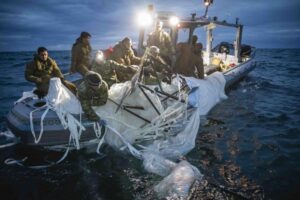The head of North American Aerospace Defense Command (NORAD) said the Chinese high-altitude surveillance balloon that passed across the U.S., and similar balloon incidents that went undetected in recent years, have highlighted a “domain awareness gap.”
Air Force Gen. Glen VanHerck, commander of NORAD and U.S. Northern Command, was asked during a press briefing on Monday about reports that at least three such balloons flew into U.S. airspace during the Trump administration without being detected, with the incidents being discovered after the fact.

“Every day as the NORAD commander it’s my responsibility to detect threats to North America. I will tell you that we did not detect those threats. And that’s a domain awareness gap that we have to figure out. But I don’t want to go into further detail,” VanHerck responded. “The intel community, after the fact, I believe had been briefed already. [They] assessed those threats…from additional means [of collection] and made us aware of those balloons that were previously approaching North America or transited North America.”
The Pentagon first announced it was tracking a suspected Chinese surveillance balloon last week, which traveled eastward across the United States, before airspace was closed off the coast of South Carolina on Saturday for the military to shoot it down.
VanHerck told reporters the Raytheon Technologies [RTX]-built AIM-9X Sidewinder missile fired from an F-22 fighter aircraft was the safest and most effective option for taking out the balloon, with operations ongoing now to recover debris (Defense Daily, Feb. 6).
Ret. Navy Adm. Harry B. Harris Jr., former head of U.S. Indo-Pacific Command, testified Tuesday at a House Armed Services Committee (HASC) hearing on threats from China, and cited concern over whether the U.S.’ current sensing capability is adequate for detecting such airspace intrusions.
“That ought to concern all of us. So I think getting the parts of this balloon together and understanding [China’s] surveillance [capabilities] will help,” Harris said.
Rep. Mike Rogers (R-Ala.), the new HASC chair, said during Tuesday’s hearing he believes the Chinese surveillance balloon was “intentionally launched as a calculated show of force.”
Sen. Jack Reed (D-R.I.), chair of the Senate Armed Services Committee, told reporters on Tuesday he thought the Biden administration’s conduct related to the Chinese balloon “was extremely appropriate,” while noting Congress should be briefed on how the system was able to breach U.S. airspace and the challenges with detecting earlier incidents.
“We’ll certainly look at that. But I think the latest incident was picked up fairly quickly and transmitted to the president and the national security team very, very quickly. But that’s obviously something we want to check,” Reed said during a Defense Writers’ Group discussion. “That’s one of the key questions that we’re going to pose to the intel and Department of Defense briefers. Why did we detect this system and we failed to detect the other systems? So I don’t want to be coy, that’s a question I have to get answered.”
VanHerck during his briefing declined to give specifics on the operation to track the balloon as it traversed across the U.S. or the specific locations it flew over, noting his plans to brief Congress on the incident.
“We utilized multiple capabilities to ensure we collected and utilized the opportunity to close intel gaps,” VanHerck said. “I would just tell you, we took every precaution to ensure any sites in the way were covered and that we minimized any collection.”